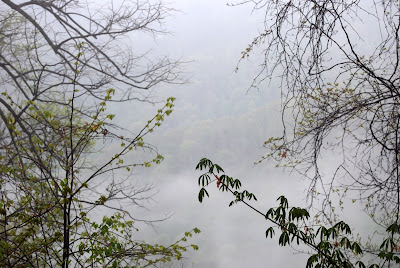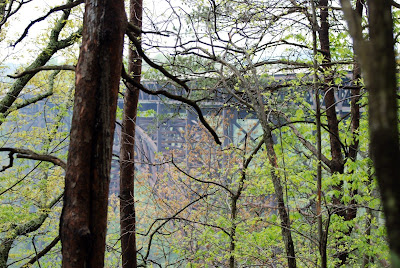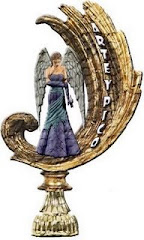 West Virginia is a place of history, myths and legends. The past rolls off the hills like the West Virginia fog. The fog and rain rolled in overnight and greets us early on Wednesday morning. As we pile into the bus and head up the narrow mountain road to Sugar Creek Ridge I can hear the strains of John Denver singing in my brain…
West Virginia is a place of history, myths and legends. The past rolls off the hills like the West Virginia fog. The fog and rain rolled in overnight and greets us early on Wednesday morning. As we pile into the bus and head up the narrow mountain road to Sugar Creek Ridge I can hear the strains of John Denver singing in my brain…"Almost heaven, West Virginia, Blue Ridge Mountains, Shenandoah River…
…life is old there, older than the trees, younger than the mountains, blowing like a breeze,
Well, today they are taking me through mist and clouds up to a place where the warblers dwell.
Our guides today are Geoff Heeter and Wil Hershberger. Geoff is the owner of Opossum Creek Retreat where most of us are staying for the New River Birding Festival. Wil is a quiet man with ears like a bat in his ability to hear sounds. As we pile out of the bus in the mist on the narrow mountain road Wil starts to call like a barred owl to flush the birds. Apparently if the little birds think a barred owl is around they will hurry in and try to mob it and chase it away. Having just recently heard a barred owl at Nina’s house in Ohio, I was amazed at how authentic he sounded. And soon the warblers came in.
 We saw a hooded warbler, a black-throated green, cerulean warbler and a yellow-throated warbler. Wil called in an American Redstart as well, but my favorite and the only one I got a halfway decent picture of is the Worm-eating warbler. While its name is not so attractive, I think it is a marvelous bird with its striped ochre head. Sometimes I really like the subtle colors of the woodland birds over the flashy colors of the others. This little warbler sat up on a branch and sang its song in the constant drizzle for us. You can see the drops of water hanging on the branches here.
We saw a hooded warbler, a black-throated green, cerulean warbler and a yellow-throated warbler. Wil called in an American Redstart as well, but my favorite and the only one I got a halfway decent picture of is the Worm-eating warbler. While its name is not so attractive, I think it is a marvelous bird with its striped ochre head. Sometimes I really like the subtle colors of the woodland birds over the flashy colors of the others. This little warbler sat up on a branch and sang its song in the constant drizzle for us. You can see the drops of water hanging on the branches here.The Sugar Creek Ridge Road is narrow and winding. Cut into the side of the mountain, it rises steeply on one side and drops precipitously on the other. While there are woods all around us, there is nowhere to sneak off safely and relieve your bladder, especially if you are a woman. And, as usual, we have men driving the bus and leading the trip. Men with bladders of steel and no mercy! Being able to use the restroom is one of the biggest challenges on these birding treks. I finally find a small dirt track that veers off in a somewhat level direction after another woman points it out to me. Fortunately, everyone else is enthralled with looking at the birds and the mist is as thick as ever.
We walk the dirt road for awhile but the rain starts to pick up and it soon drives us off the mountain. Geoff Heeter decides we should take a break in Anstead at the Blue Smoke Café. We are greeted by a gracious hostess and served delicious hot coffee. Here in this small town we also find flush toilets! Yay!

After our stop we travel down Rt. 60 to Hawk’s Nest State Park. Fog continues to roll off the mountainside lending an air of mystery to the day.

KatDoc lost deep in thought sitting under the pavilion where we eat our lunch.

Then, it’s down the hill and across the road for more bird watching. You can see how wet it is from Nina’s coat.
 We form our own little Birder’s Parade as we cross RT. 60 to the Hawk’s Nest Overlook.
We form our own little Birder’s Parade as we cross RT. 60 to the Hawk’s Nest Overlook.

I wrote about this disaster in an earlier post. Here is the sign marking the location of the disaster.
 And below us on the riverbank as if in homage to the dead workers a flock of Black Vultures lurks. (Click on photo to enlarge. You can see the black vultures on the rocks.)
And below us on the riverbank as if in homage to the dead workers a flock of Black Vultures lurks. (Click on photo to enlarge. You can see the black vultures on the rocks.) Hawk's Nest tunnel with water flowing through it. Watch a short historical video about the disaster here.
Hawk's Nest tunnel with water flowing through it. Watch a short historical video about the disaster here. View from the Hawk's Nest overlook. We watched four cormorants fly by below us from this vantage point.
View from the Hawk's Nest overlook. We watched four cormorants fly by below us from this vantage point. Yellow-throated warbler seen on the path from the overlook.
Yellow-throated warbler seen on the path from the overlook. This beautiful stone building is actually the restroom at Hawk's Nest State park. It's the prettiest restroom we used on our trip.
This beautiful stone building is actually the restroom at Hawk's Nest State park. It's the prettiest restroom we used on our trip. Aall around the mountains are in bloom. I love the pink flowers of the Redbud trees...
Aall around the mountains are in bloom. I love the pink flowers of the Redbud trees... ...and the lovely white cross-shaped blossoms of dogwood. Yes, "take me home, country roads..."
...and the lovely white cross-shaped blossoms of dogwood. Yes, "take me home, country roads..." ...back to Burnwood where the day began. We eat breakfast here everyday now, gathered in the predawn darkness beneath this pavilion where hot coffee, scrambled eggs, sausage, bacon and fried potatoes greet us every morning. Today's rain has driven us home early and so we decide to see what birds we can see here at Burnwood before heading back to the Farmhouse for the afternoon.
...back to Burnwood where the day began. We eat breakfast here everyday now, gathered in the predawn darkness beneath this pavilion where hot coffee, scrambled eggs, sausage, bacon and fried potatoes greet us every morning. Today's rain has driven us home early and so we decide to see what birds we can see here at Burnwood before heading back to the Farmhouse for the afternoon. Nina and KatDoc scoping out the birds in the surrounding woods. Today was a day full of mist, rain, adventure and birds. Yes, we were wet, but we all had a great time and I would do it all again if given the chance.
Nina and KatDoc scoping out the birds in the surrounding woods. Today was a day full of mist, rain, adventure and birds. Yes, we were wet, but we all had a great time and I would do it all again if given the chance.- Red-tailed hawk
- Pileated woodpecker
- White-breasted nuthatch
- Carolina chickadee
- Tufted titmouse
- Yellow-throated vireo*
- Red-eyed vireo
- Blue-headed vireo
- Black and white warbler
- Hooded Warbler
- Black-throated green warbler
- Worm-easting warbler*
- Cerulean warbler*
- Yellow-throated Warbler*
- American Redstart
- Indigo bunting
Anstead
- Chimney Swift
- Starling
- American Robin
- Common Grackle
Hawks Nest State Park
- Canada Goose
- Double-crested cormorant
- Black vulture
- turkey Vulture
- American crow
- Pileated woodpecker
- Eastern Phebe
- Robin
- Tufted titmouse
- Carolina chickadee
- Red-eyed vireo
- Ovenbird
- Blackbrunian warbler
- Yellow-throated warbler
- Northern cardinal
- Brown-headed cowbird
Burnwood Picnic Area, Fayetteville, WV
- Turkey Vulture
- Crow
- Carolina chickadee
- Tufted Titmouse
- Robin
- Woodthrush
- Indigo bunting
- Eastern Towhee
- Chipping sparrow
- Northern Cardinal
*Life Birds
I submitted all of these bird counts to eBird and to my amazement, I am now one of the top 100 eBirders in Fayetteville, WV. How can this be? Well, the truth is, the Cornell Lab of Ornithology needs more eBirders. Just recently they started a blog of their own called Chip Notes-eBird Buzz. If you don't think you can actually make a difference, here is their first post explaining why they need more ebirders and yes, you can do it! (Click on the link to go to the original post.)
Do you eBird?
Based on recent research we've learned that roughly 70,000 people use eBird more than 50 times a year to gather information on birds. Most surprising to us was the fact that just 10,000 people entered data into eBird at least once, and even more remarkable is that just 2500 people entered more than 50 eBird checklists last year. What this tells us is that there is a large community of people out there using eBird as an information source, but a relative few actually contribute data. We want to better understand what drives our users, and ultimately participation in eBird. Why people submit data, why they don't, what's good and bad about eBird? Helping us answer these questions will make eBird a better tool for birders, and ultimately put more data into the hands of scientists and conservationists. With that, we ask you, the eBird community how we can be better...
Posted by Brian Sullivan at 5:40 PM















































